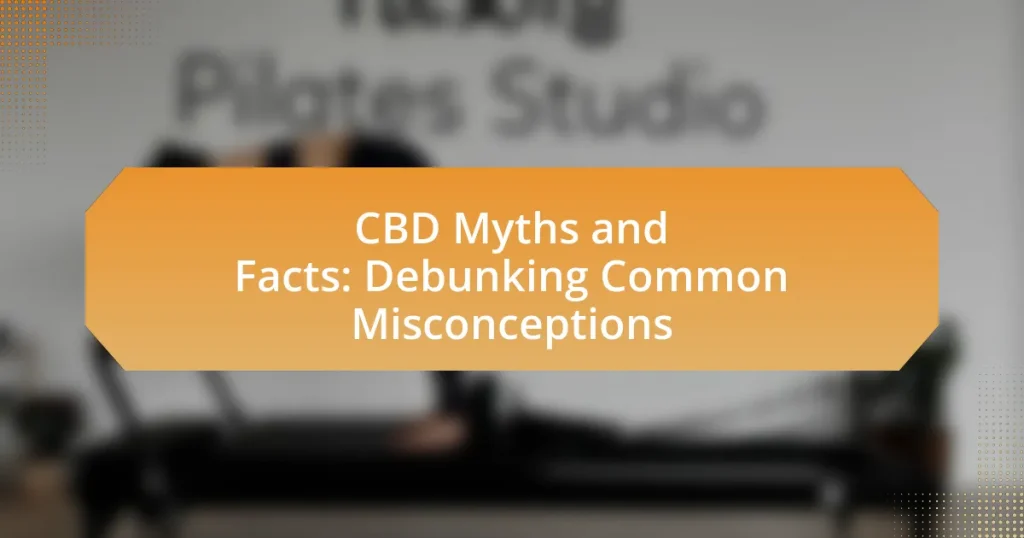CBD, or cannabidiol, is a non-psychoactive compound derived from hemp, often surrounded by misconceptions regarding its effects, legality, and medical applications. Common myths include the belief that CBD causes a high, is illegal everywhere, and can cure all ailments. This article explores the origins of these misconceptions, the role of media and personal anecdotes in shaping perceptions, and the scientific evidence supporting CBD’s therapeutic benefits. Additionally, it addresses the legal considerations surrounding CBD, the importance of product quality through lab testing, and best practices for safe usage. Understanding these aspects is crucial for consumers navigating the evolving landscape of CBD products.

What are the common myths surrounding CBD?
Common myths surrounding CBD include the belief that it causes a high, that it is illegal everywhere, and that it can cure all ailments. CBD, or cannabidiol, is a non-psychoactive compound derived from hemp, meaning it does not produce the intoxicating effects associated with THC, the psychoactive component of cannabis. Legally, CBD is permitted in many regions, provided it contains less than 0.3% THC, as established by the 2018 Farm Bill in the United States. Furthermore, while CBD has shown promise in alleviating certain conditions such as anxiety and epilepsy, it is not a universal cure-all, and claims of its effectiveness for every health issue lack scientific backing.
Why do misconceptions about CBD exist?
Misconceptions about CBD exist primarily due to a lack of comprehensive scientific understanding and the influence of historical stigma associated with cannabis. The complex legal status of CBD, varying regulations across regions, and the conflation of CBD with THC, the psychoactive component of cannabis, contribute to confusion. Additionally, anecdotal claims and misinformation spread through social media and marketing tactics further perpetuate these misconceptions. For instance, a survey by the Brightfield Group found that 64% of CBD users were unsure about its legal status, highlighting the widespread uncertainty surrounding the substance.
What role does media play in shaping CBD perceptions?
Media plays a crucial role in shaping perceptions of CBD by influencing public opinion and disseminating information. Through various platforms, including news articles, social media, and advertisements, media outlets can either promote positive narratives about CBD’s benefits or propagate misconceptions and stigma associated with its use. For instance, a study published in the Journal of Cannabis Research found that media coverage significantly impacts consumer attitudes towards CBD, with positive portrayals leading to increased acceptance and usage. Conversely, negative reporting can reinforce existing myths and fears, highlighting the media’s powerful influence in framing the public’s understanding of CBD.
How do personal anecdotes contribute to CBD myths?
Personal anecdotes contribute to CBD myths by creating a perception of efficacy based on individual experiences rather than scientific evidence. These personal stories often circulate in social media and informal discussions, leading to widespread beliefs that may not be substantiated by clinical research. For instance, a person claiming that CBD cured their chronic pain can influence others to believe in its universal effectiveness, despite the lack of rigorous studies supporting such claims. This phenomenon is exacerbated by confirmation bias, where individuals favor information that aligns with their beliefs, further entrenching myths surrounding CBD.
What are some prevalent myths about CBD?
Some prevalent myths about CBD include the belief that it causes a high, that it is illegal everywhere, and that it can cure all ailments. CBD, or cannabidiol, is a non-psychoactive compound derived from hemp, meaning it does not produce the intoxicating effects associated with THC, the psychoactive component of cannabis. Legally, CBD is permitted in many regions, provided it contains less than 0.3% THC, as established by the 2018 Farm Bill in the United States. Additionally, while CBD has shown promise in alleviating certain conditions such as epilepsy and anxiety, it is not a universal cure-all, and its efficacy can vary based on individual circumstances and the specific health issue being addressed.
Is CBD the same as marijuana?
CBD is not the same as marijuana. CBD, or cannabidiol, is a compound found in cannabis plants, including marijuana, but it does not produce the psychoactive effects associated with marijuana, which is primarily due to another compound called THC (tetrahydrocannabinol). While both CBD and marijuana come from the cannabis plant, CBD can be derived from hemp, a variety of cannabis that contains less than 0.3% THC, making it non-intoxicating and legal in many regions. This distinction is crucial in understanding the differences between CBD and marijuana.
Can CBD get you high?
CBD cannot get you high. Unlike THC, the psychoactive compound in cannabis, CBD does not produce intoxicating effects. Research indicates that CBD interacts with the body’s endocannabinoid system differently than THC, primarily influencing receptors that do not lead to the euphoric sensations associated with a high. Studies, such as those published in the Journal of Psychopharmacology, confirm that CBD does not alter mental state or impair cognitive function, reinforcing its non-psychoactive nature.
Is CBD only for specific medical conditions?
CBD is not only for specific medical conditions; it has a broader range of potential applications. Research indicates that CBD may benefit various health issues, including anxiety, chronic pain, and inflammation, beyond just specific medical diagnoses. For instance, a study published in the Journal of Pain Research in 2018 found that CBD effectively reduced chronic pain in patients, suggesting its versatility in addressing multiple health concerns rather than being limited to certain conditions.

What are the facts about CBD?
CBD, or cannabidiol, is a non-psychoactive compound derived from the cannabis plant, known for its potential therapeutic benefits. Research indicates that CBD may help alleviate anxiety, reduce inflammation, and manage chronic pain, as evidenced by a study published in the Journal of Experimental Medicine, which found that CBD significantly reduced chronic pain and inflammation in animal models. Additionally, CBD is legal in many regions, provided it contains less than 0.3% THC, as outlined in the 2018 Farm Bill in the United States. Furthermore, the World Health Organization has reported that CBD exhibits no effects indicative of abuse or dependence potential, supporting its safety profile.
How is CBD derived and what are its properties?
CBD, or cannabidiol, is derived from the Cannabis sativa plant, specifically from its flowers, leaves, and stalks. The extraction process typically involves methods such as CO2 extraction, ethanol extraction, or oil infusion, which separate CBD from other cannabinoids and compounds in the plant. CBD possesses various properties, including anti-inflammatory, analgesic, and anxiolytic effects, which have been supported by studies indicating its potential therapeutic benefits in conditions like anxiety, chronic pain, and epilepsy. For instance, a study published in the Journal of Experimental Medicine found that CBD significantly reduced chronic inflammatory and neuropathic pain in rodents, highlighting its analgesic properties.
What are the different sources of CBD?
CBD, or cannabidiol, is primarily sourced from two main types of plants: hemp and marijuana. Hemp, a variety of the Cannabis sativa plant, contains high levels of CBD and low levels of THC, making it a popular source for CBD products. In contrast, marijuana also contains CBD but has higher concentrations of THC, which is the psychoactive component. The legal distinction between these sources is significant; hemp-derived CBD is legal in many regions, while marijuana-derived CBD may be subject to stricter regulations. This differentiation is supported by the 2018 Farm Bill in the United States, which legalized hemp cultivation and the production of hemp-derived CBD products.
What scientific studies support the benefits of CBD?
Numerous scientific studies support the benefits of CBD, particularly in areas such as anxiety, epilepsy, and pain management. For instance, a study published in the New England Journal of Medicine in 2017 demonstrated that CBD significantly reduced seizure frequency in patients with Dravet syndrome, a severe form of epilepsy, with a reduction of 39% in seizures compared to a placebo. Additionally, a 2019 review in the journal Frontiers in Psychology highlighted that CBD may effectively reduce anxiety in both human and animal studies, suggesting its potential as a treatment for anxiety disorders. Furthermore, research published in the Journal of Pain in 2018 indicated that CBD could alleviate chronic pain by interacting with the endocannabinoid system, providing evidence for its analgesic properties. These studies collectively validate the therapeutic potential of CBD across various medical conditions.
What are the legal considerations regarding CBD?
The legal considerations regarding CBD primarily involve its classification under federal and state laws. CBD derived from hemp with less than 0.3% THC is federally legal in the United States due to the 2018 Farm Bill, which legalized hemp cultivation and production. However, individual states may have their own regulations that can restrict or regulate CBD use, including licensing requirements for production and sales. Additionally, the FDA has specific guidelines regarding the marketing and labeling of CBD products, particularly in food and dietary supplements, which must comply with safety and efficacy standards.
How does the legality of CBD vary by region?
The legality of CBD varies significantly by region, with some areas allowing its use and others imposing strict regulations or outright bans. In the United States, for example, the 2018 Farm Bill legalized hemp-derived CBD containing less than 0.3% THC at the federal level, but individual states have the authority to regulate or prohibit its sale and use, leading to a patchwork of laws. Conversely, in countries like Canada, CBD is legal and regulated under the Cannabis Act, while in regions such as the European Union, CBD derived from hemp is generally legal, provided it meets specific THC content requirements. This variation is influenced by local laws, cultural attitudes towards cannabis, and health regulations, making it essential for consumers to understand the specific legal status of CBD in their region.
What regulations govern CBD products?
CBD products are primarily governed by the Agricultural Improvement Act of 2018, commonly known as the Farm Bill, which legalized hemp-derived CBD containing less than 0.3% THC at the federal level in the United States. Additionally, the Food and Drug Administration (FDA) regulates CBD products under the Federal Food, Drug, and Cosmetic Act, particularly concerning labeling, safety, and health claims. States may also impose their own regulations, leading to a patchwork of laws that can vary significantly across the country. For instance, some states have established specific licensing requirements for the sale of CBD products, while others may restrict the types of products that can be sold.

How can consumers navigate CBD products effectively?
Consumers can navigate CBD products effectively by researching product labels, understanding dosage recommendations, and verifying third-party lab testing. Researching product labels helps consumers identify the concentration of CBD, the presence of other cannabinoids, and any additives or fillers. Understanding dosage recommendations is crucial, as individual responses to CBD can vary significantly; starting with a low dose and gradually increasing it is often advised. Verifying third-party lab testing ensures that the product has been tested for purity and potency, providing consumers with confidence in the product’s quality and safety. According to a 2020 study published in the Journal of Cannabis Research, accurate labeling and third-party testing are essential for consumer safety and informed decision-making in the CBD market.
What should consumers look for when choosing CBD products?
Consumers should look for third-party lab testing when choosing CBD products. This ensures that the product has been independently verified for potency and purity, confirming it contains the advertised levels of CBD and is free from harmful contaminants. According to a study published in the Journal of the American Medical Association, many CBD products on the market do not contain the amount of CBD they claim, highlighting the importance of lab testing for consumer safety and product reliability. Additionally, consumers should check for clear labeling that includes the source of the hemp, extraction methods, and any additional ingredients to make informed choices.
How can lab testing influence product quality?
Lab testing significantly influences product quality by ensuring that products meet safety, potency, and purity standards. Through rigorous analysis, lab testing identifies the presence of active compounds, contaminants, and any deviations from labeled claims. For instance, a study published in the Journal of the American Medical Association found that nearly 70% of CBD products tested did not contain the amount of CBD claimed on the label, highlighting the importance of lab testing in verifying product accuracy. This process not only protects consumers but also enhances brand credibility and compliance with regulatory requirements.
What are the differences between full-spectrum, broad-spectrum, and isolate CBD?
Full-spectrum CBD contains all cannabinoids, terpenes, and other compounds found in the cannabis plant, including THC, which is present in trace amounts (up to 0.3%). Broad-spectrum CBD includes multiple cannabinoids and terpenes but is free of THC, making it suitable for those who want to avoid THC while still benefiting from the entourage effect. Isolate CBD is the purest form, consisting of only CBD without any other cannabinoids or terpenes, providing a THC-free option that lacks the entourage effect. These distinctions are crucial for consumers to choose the right product based on their preferences and needs.
What are best practices for using CBD safely?
To use CBD safely, individuals should start with a low dose and gradually increase it while monitoring their body’s response. This approach minimizes the risk of adverse effects and allows users to find their optimal dosage. Research indicates that starting with a low dose, such as 5-10 mg, and adjusting based on personal experience can lead to safer usage (Source: “Cannabidiol in inflammatory bowel diseases: a brief overview,” by Iffland et al., 2017). Additionally, users should consult with a healthcare professional, especially if they are taking other medications, to avoid potential interactions. It is also essential to purchase CBD products from reputable sources that provide third-party lab testing results, ensuring product quality and accurate labeling.
How can users determine the right dosage of CBD?
Users can determine the right dosage of CBD by starting with a low dose and gradually increasing it until they achieve the desired effects. Research indicates that individual factors such as body weight, metabolism, and the specific condition being treated can influence the optimal dosage. A common recommendation is to begin with 1-5 mg of CBD per 10 pounds of body weight, adjusting as necessary based on personal response. Additionally, consulting with a healthcare professional can provide tailored guidance, ensuring safety and efficacy in dosage determination.
What precautions should be taken when using CBD with other medications?
When using CBD with other medications, it is crucial to consult a healthcare professional to avoid potential drug interactions. CBD can affect the metabolism of certain medications by inhibiting cytochrome P450 enzymes, which are responsible for metabolizing many drugs. For instance, studies indicate that CBD can increase the blood levels of drugs like warfarin, leading to an increased risk of bleeding. Therefore, monitoring and adjusting medication dosages may be necessary when combining CBD with other treatments.
What resources are available for further education on CBD?
Resources available for further education on CBD include academic journals, online courses, and reputable websites. Academic journals such as the Journal of Cannabis Research provide peer-reviewed studies on CBD’s effects and applications. Online platforms like Coursera and Udemy offer courses on cannabis science and CBD specifically, often created by experts in the field. Additionally, websites like Project CBD and the National Institute on Drug Abuse provide comprehensive information and research findings related to CBD, ensuring that learners access credible and scientifically-backed content.



